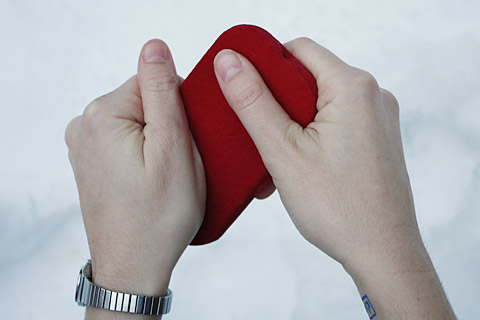There's a lot to be said for warm hands. If the rest of your body is freezing a heat source in the hand can make you feel a whole lot better. A hot mug of mulled wine when standing at an icy Christmas market comes to mind here. At first it is perhaps too hot to drink, but it feels good to warm your numb fingers on the mug. In recent years a wave of gel cushions has surged through the discount stores, but they failed to convince people lastingly and were not able to overcome their status as gimmicks. Outdoor outfitters have also offered some functional, more-or-less well-conceived hand-warmers which, however, are mostly uninspired from a design point of view. But if you look back on the glorious, centuries-long history of hand-warmers, you can't help wanting to call upon as many designers as possible to take up this currently disregarded product typology and bring it to life as quickly as possible.
Early forms of hand-warmers were referred to as heat balls and were used between the 8th and 18th centuries. These miniature ovens measuring approx. 10 cm in diameter were made of metal such as gold, silver, bronze, copper, brass or iron. The hollow balls could be opened to hold heated substances, embers and flames were held horizontally thanks to the gimbal mounting. Glimmering charcoal, red-hot pieces of metal, wax candles, oil or spirits provided pleasant temperatures. The valuable heat balls were often decorated - for example with plant or animal motifs - and kept in elaborately made dishes or cases. Sometimes they were worn on rings and chains - like pieces of jewelry. Perhaps also to override the burning smell some heat balls were combined with musk apples - scent balls - so that the scent would unfold with the heat. Originally, heat balls were used by priests to temper their hands so that they could better deliver the holy sacrament. Later the occasional aristocrat enjoyed the comfort of the small wearable ovens.
Today, in an age of heated living rooms and offices, pocket hand-warmers are enjoyed by the cold when traveling, pursuing outdoor sports or attending open-air festivals. The models currently available differ mostly in the fuels they use. Those which employ lighter fluid, by manufacturers such as Zippo and Peacock, look like larger siblings of the well-known benzene lighters. One filling lasts up to twelve hours, the temperature cannot be controlled and the fire, unfortunately, cannot be extinguished prematurely.
Models that use small bits of charcoal are also in wide use, for example those made by Relags or Herbertz which, with their elongated format and velvet covering, look like a glasses case or jewelry box. One briquette burns for about three hours; the heat can be intensified by burning the rod at both ends; when the heat source is no longer required it can be extinguished.
Pocket hand-warmers with electrically rechargeable batteries such as the "Eneloop Kairo" by Sanyo look like batteries, Once charged they last almost three hours, the temperature can be regulated in three levels - and of course they can also be switched off.
While the historical heat balls had a high representative value, pocket hand-warmers today are purely functional. Heat balls were used to decorate tables or were even worn as jewelry while pocket hand warmers simply disappear into pockets. Perhaps it is simply due to the fact that there are no outstanding contemporary hand-warmer designs around. But who knows, perhaps some numb-fingered industrial designer will feel called upon to turn this practical pocket companion into a decorative accessory for snowy winter days.



 Hand warmer by Zippo
Hand warmer by Zippo





 Models that use small bits of charcoal by Relags, all photos: Dimitrios Tsatsas, Stylepark
Models that use small bits of charcoal by Relags, all photos: Dimitrios Tsatsas, Stylepark





 Rechargeable Hand warmer "eneloop kairo" by Sanyo
Rechargeable Hand warmer "eneloop kairo" by Sanyo

 gel cushion by Herbertz
gel cushion by Herbertz

